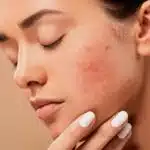When it comes to staying safe under the sun, we need to clear up some myths. Many think the sun’s heat is what hurts us. But it’s really the invisible UV rays that cause damage, not the temperature. So, even on a cloudy day, your skin could be at risk because UV rays go through clouds.
And here’s another important fact: UV rays can hurt you every day of the year, not just in the summer. That’s why using sunscreen is key, no matter what the season is. Skipping sunscreen could lead to skin cancer and other harmful skin problems.
Key Takeaways
- Sun damage is caused by UV radiation, not temperature.
- UV radiation can penetrate clouds and be more intense due to reflection.
- Using sunscreen is important year-round, not just during the summer.
- Neglecting to use sunscreen can increase your risk of skin cancer and other sun-related skin damage.
- It’s crucial to choose a broad-spectrum sunscreen with an SPF of at least 30 to protect your skin from both UVA and UVB rays.
Understanding Sun Protection Factor
The sun protection factor (SPF) is key in keeping our skin safe. It shows how well a sunscreen guards against the sun’s harmful UV radiation. An SPF 30 sunscreen, for example, lets just 1/30th of the UVB rays through to the skin. This means it offers 30 times more protection than not using sunscreen.
What is SPF?
SPF measures how effective a sunscreen is at stopping UVB rays from burning the skin. The higher the SPF, the more protection you get from sunburn. A sunscreen with SPF 30 or higher is best. It can block up to 97% of the UVB rays. But remember, SPF doesn’t tell us about UVA protection, which is also important for avoiding skin damage and cancer.
The Importance of SPF
Using sunscreen with the right SPF is key for keeping your skin healthy. It helps prevent sunburn, early aging, and skin cancer. The Centers for Disease Control and Prevention (CDC) says to choose a broad-spectrum sunscreen of at least SPF 30 when you’re out in the sun. Always apply and reapply it properly for full protection.
SPF and UV Radiation
Even though SPF blocks most UVB rays, some can still reach the skin. This means you can still get sunburned on cloudy days. Also, UV rays can bounce off water, sand, and snow, upping your exposure risk. That’s why choosing a broad-spectrum sunscreen chemicals in sunscreen is crucial. Reapply it often, especially on long sunny days, to protect against both UVA and UVB rays.
Also Read : Navigating the world of skincare treatments from facials to peels
Cloudy Days and Sun Safety
Sun damage comes from the ultraviolet (UV) radiation the sun sends out, not just its temperature. This means you can get hurt by the sun even when it’s cloudy. The environmental protection agency don’t always keep the UV rays away. They sometimes make the UV rays stronger. That’s why you should always protect your skin from the sun, no matter if it’s sunny or not.
UV Rays and Clouds
The sun’s UV rays are what mainly harm our skin protection from uvb rays. They can reach us through the clouds. Actually, sometimes clouds can make UV radiation stronger level of sunburn protection provided. This means your skin faces a higher risk of damage when it’s cloudy out.
Also Read : Finding The Right Fit For Your Needs By Understanding Loan Options
The Myth of “Windburn”
Some people think “windburn” can hurt your skin just by the wind. But it’s not true. Ultraviolet (UV) radiation from the sun is the real cause of skin issues. So, we need to protect our skin from the sun, no matter if it’s windy or how many clouds there are.
To keep your skin safe, check the daily sun protection times. When the UV index is 3 or more, use broad-spectrum sunscreen with an SPF of 30 or spf 15 sunscreen allows higher. This applies whether it’s sunny or cloudy.
Also Read : Your Path To Ageless Beauty Starts Here: Introducing Life Cell Skincare
Tanning and Skin Damage
Many think a tan is safe, but that’s not true. If your skin gets darker from the sun, it means your skin is hurt, even if you don’t see redness or peel. Your skin turns dark to shield you from UV rays, trying to protect itself sunscreen allows them to stay.
The Truth About Tanning
The skin gets darker when it meets the sun’s UV radiation. This is the body’s way of defending itself. It produces more melanin, which makes the skin darker, aiming to protect itself from harm.
But this isn’t a sign your skin is safe. A tan shows your skin is in trouble and is doing all it can to protect you. Getting a tan, whether outside or in a tanning bed, is bad for your skin. It increases the chance of skin cancer and speeds up photoaging. This means you may get wrinkles, age spots, and other damage sooner than expected.
Skin Cells in Trauma
UV rays cause many reactions in our skin. The skin’s DNA gets hurt, and more melanin is made to keep us safe. That’s why our skin turns dark when we tan, showing it’s trying to protect us.
But, this doesn’t mean the skin is fine. The skin is actually in trouble, and it’s trying to save itself from UV harm. Too much sun can make things worse. It can hurt our DNA more, raise the risk of skin cancer, and speed up signs of photoaging.
Remember, there’s no such thing as a safe tan. Not even a tan shows your skin is okay. Always protect your skin. Use use a broad-spectrum sunscreen that’s SPF 30 or more. Also, wear clothes that cover you well and avoid the sun during its strongest hours rarely or never use sunscreen.
Also Read : How To Get Financial Well Being To Raise Your Credit Score?
Cosmetic SPF and Additional Protection
Many people think their daily makeup or moisturizer with SPF is enough sun protection. But these products have limits you should know about overexposure to the sun.
If a cosmetic product doesn’t have SPF50 or higher marked on it, add extra sunscreen for long sun exposure. Most cosmetic items give very little to no defense, unlike the strong shield of an SPF50+ protection against uva.
Makeup and Sunscreen
Applying enough sunscreen is key for good UV protection. People often don’t use the right amount, which weakens the protection. Cosmetics like foundation or powder don’t shield against the sun as well as sunscreen does ultraviolet protection factor spf is not directly related.
Reapplying Sunscreen
Remember to reapply sunscreen every two hours, especially if swimming or sweating. Sunscreens labeled as being water-resistant also need reapplying. Without this, your skin won’t have the defense it needs against the sun’s harm.
Sun Protection Factor and Skin Tones
It’s key to know that the risk of skin cancer varies by skin tone. Lighter skin tones are more prone to sun damage and cancer. But, dark skin tones are not fully protected from UV harm relation between sun protection factor.
Also Read : From Shave To Shine: Simplifying Your Daily Men’s Skincare Routine
Risk of Skin Cancer Across Skin Tones
Those with fairer skin face more melanoma risk because they have less melanin. Melanin is a natural sun protector. However, darker skin tones are still at risk. They could get other serious cancers if they often expose their skin to the sun.
No matter your skin color, always use a broad-spectrum sunscreen with an SPF of at least 30. Also, remember to reapply it when you’re out in the sun. Protecting your skin from UV radiation is vital. It helps lower skin cancer odds, and avoid early aging and sunspots.
Also Read : Skincare For Dark Spots: Fade And Even Tone Tips
FAQs
Q: What does SPF stand for?
A: SPF stands for Sun Protection Factor, which indicates the level of protection a sunscreen product provides against UVB rays sunscreen can offer.
Q: Should I choose a sunscreen with SPF 30 or higher?
A: Yes, it is recommended to choose a sunscreen with SPF 30 or higher to ensure adequate protection from the sun’s harmful rays protect you from the sun.
Q: How often should I apply sunscreen?
A: It is advised to reapply sunscreen every two hours or immediately after swimming or sweating to maintain its effectiveness amount of sunscreen applied.
Q: What type of sunscreen should I use for better protection?
A: Opt for a broad-spectrum sunscreen that protects against both UVA and UVB rays for comprehensive sun protection sunscreen is an important way protection from uva.
Q: Does sunscreen protection vary based on its SPF value?
A: Yes, the SPF of 15 value determines the level of protection against UVB rays, with higher SPF providing more protection compared to lower SPFs.
Q: Are there any misconceptions about SPF 50 being significantly better than SPF 30?
A: While SPF 50 offers slightly higher protection, the difference between SPF 30 and SPF 50 is not substantial in terms of sun protection stay in the sun.
Q: What should I consider when choosing a sunscreen for daily use?
A: When choosing sunscreen, consider factors like your skin type, activities, and the duration of sun exposure to select the most suitable product.
Q: Can sunscreen alone provide complete protection from the sun?
A: While sunscreen is essential, it is recommended to use other sun protection methods like wearing hats, sunglasses, and seeking shade for comprehensive sun protection.
Q: What does SPF stand for and what does it mean?
A: SPF stands for Sun Protection Factor. It measures the level of protection a sunscreen product provides against UVB rays that can cause sunburn sunscreen protects.
Q: Should I use sunscreen even on cloudy days?
A: Yes, it is recommended to use sunscreen every day, even on cloudy days. UV rays can penetrate through clouds and still cause skin damage.
Q: How do I choose the right sunscreen?
A: When choosing a sunscreen, look for one with at least know that spf 30 or higher, broad spectrum protection to shield against UVA and UVB rays, and water-resistance if you’ll be sweating or swimming broad spectrum sunscreen.
Q: How much sunscreen should I apply and how often?
A: It is recommended to apply about a nickel-sized amount of sunscreen to cover your face and a shot glass amount to cover your body. Reapply every two hours or more frequently if swimming or sweating.
Q: What is the difference between SPF 30 and SPF 50?
A: SPF 30 blocks about 97% of UVB rays, while SPF 50 blocks about 98%. Both provide high levels of protection, but SPF 50 offers slightly more.
Q: Are there specific types of sunscreen I should choose?
A: Choose a sunscreen that suits your skin type, whether it’s a lotion, spray, or gel. Look for products labeled “broad spectrum” to ensure protection against both UVA and UVB rays.
Q: Do I need sunscreen if I have dark skin?
A: Yes, without sunscreen should be used by individuals of all skin tones. While darker skin tones have more natural protection against UV rays, sunscreen is still necessary to prevent skin damage and reduce the risk of skin cancer high spf sunscreen.








